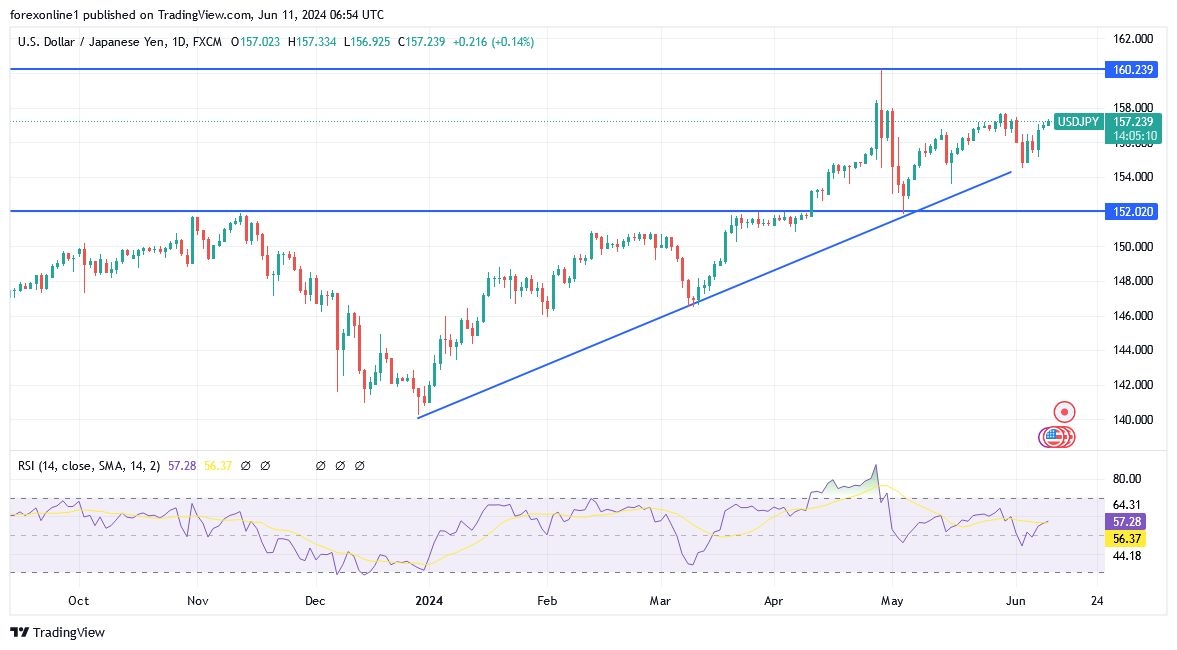- At the start of this week’s trading, the Japanese Cabinet Office revealed the country’s latest GDP figures.
- The figures were not comforting. According to the Cabinet Office, Japan’s GDP growth contracted by 0.5% on a quarterly basis, in line with market expectations.
- Accordingly, the USD/JPY price remained stable around the 157.10 resistance level, which is currently under review.
According to the results of the economic calendar, on an annual basis, the final figures for Japan's first-quarter GDP growth were confirmed to be negative at -1.8%. However, this was marginally better than estimates. Expert and analyst forecasts ranged from -1.9% to -2% for growth contraction. If the country follows this quarter with a second quarter of GDP growth contraction, it will officially be in a technical recession. In addition, Japanese household spending habits are adding to the concerns. Likewise, the same Cabinet Office figures revealed that local demand figures worsened further, from -0.1% in the first preliminary estimate to -0.2% in the second estimate today. Similarly, household consumption figures rose from -0.7% in the first preliminary figures to -0.8% today.
USD/JPY Technical analysis and Expectations Today
According to licensed trading platforms, the USD/JPY price strengthened after the news, with the USD/JPY pair rising to $157.15. The USD has accelerated sharply against the yen in recent times. In just one week, the US currency has risen by more than one dollar against the yen, from $156.08 on June 3 to $157.15 today. In one month, the yen has lost more than $1.30 against the dollar, with the USD/JPY pair rising from $155.78 on May 10 to more than $157 today.
Top Forex Brokers
More figures to come from Japan
The Japanese economy will see many statistics released this week, which could shed more light on its financial situation. On June 12, the Bank of Japan will release its latest monthly report on the Corporate Goods Price Index, specifically the Producer Price Index. Meanwhile, on Friday, June 14, the Bank of Japan will issue its latest interest rate decision. As well, the Bank of Japan is widely expected to leave interest rates unchanged. However, today's and Wednesday's figures, especially when they point to a decline in spending among households and businesses, could give the bank some food for thought.
On the other hand, affecting sentiment towards the yen against the dollar, investors are preparing for further increases in yields and volatility in the Japanese sovereign bond market as central bank officials consider reducing their massive debt holdings. Data released last week showed that the Bank of Japan bought only ¥4.5 trillion ($29 billion) of government bonds last month, the lowest amount since March 2013. Additionally, the majority of Bank of Japan watchers expect the monetary authority to decide on June 14 to reduce the amount of sovereign bonds it buys, while people familiar with the matter said such a move is under consideration.
Benchmark 10-year yields have been on a volatile journey, rising to 1.1% last month, a level not seen since 2011, only to give up about half of the gains. Furthermore, the spread between overnight swaps used for hedging and 10-year bonds has narrowed to its lowest level since 2022, reflecting concerns about the decline in Bank of Japan debt purchases. Implied volatility in debt futures has risen above the average for this year.
Overall, the Bank of Japan has accumulated more than half of the country’s government debt as a result of two decades of quantitative easing. Moreover, the ongoing weakness in the yen is adding pressure on the central bank to raise interest rates, a move that would likely help support the Japanese currency.
Meanwhile, the economic survey showed many analysts are revising their expectations for when the Bank of Japan will raise rates further in the future. Clearly, that comes as the European Central Bank has cut rates and its peers are also considering doing so. Japan’s radical easy money experiment has weakened many of the mechanisms that help investors price corporate bonds. That’s because there was less need for them at a time when authorities were pumping cash into the market.
A survey by the Bank of Japan showed that many debt investors in Japan still feel the bond market is not working properly in areas such as pricing debt and getting enough volume. But a key measure of market performance has been improving since May 2023, when the BOJ dismantled its yield curve control and negative interest rates policy. On the other hand, That has fuelled investor speculation that the central bank will seek to further reduce bond purchases to help support the health of the country’s debt market. Furthermore, The BOJ cut bond purchases in one of its regular operations for the first time this year on May 13. While the bank is keeping purchases within the planned range and has not reduced purchases in other recent operations, the move has fuelled speculation that the BOJ may formally reduce monthly purchases from the current ¥6 trillion. Ultimately, Monthly bond purchases have already slowed sharply from a record 23.7 trillion yen in January 2023.
Ready to trade our daily forex forecast? Here are the best forex brokers in Japan to choose from.

